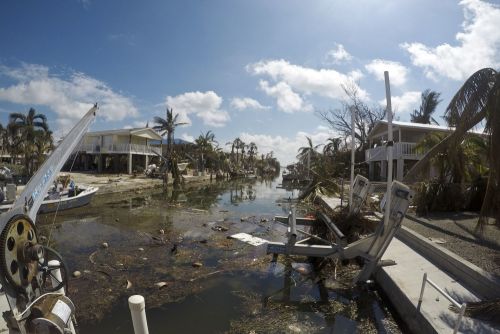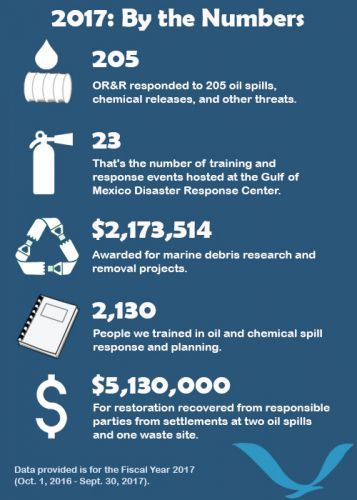2017 Accomplishments: The Year in Review
For NOAA’s Office of Response and Restoration (OR&R), Fiscal Year 2017 was a year filled with new challenges and new achievements — including a record number of incident responses and ongoing pollution response to an above-average hurricane season.
OR&R puts out an annual report as an overview of the efforts in oil and chemical spill response, shoreline restoration, marine debris reduction, and the many other tasks OR&R handled during the previous fiscal year.
Here are some of the highlights from the 2017 Accomplishments Report:
Responding to Oil and Chemical spills
The Office of Response and Restoration's Emergency Response Division (ERD) supports the U.S. Coast Guard by providing round-the-clock scientific expertise for oil and chemical spills in marine and coastal waters.
In Fiscal Year 2017 (FY17), ERD responded to a total of 205 oil spills, chemical releases, and other threats — surpassing the previous record of 201 incident responses in 2009. To help improve incident response practices, ERD also made several advances to its digital toolkit — from the creation of a new mobile app for hazardous chemicals (CAMEO Chemicals) to added updates to the GNOME™ suite, a set of modeling tools for predicting the fate and transport of pollutants (such as oil) spilled in water.
Assessing and Restoring our Shores
The Office of Response and Restoration's Assessment and Restoration Division (ARD) is responsible for evaluating and restoring coastal and estuarine habitats damaged by hazardous waste releases, oil spills, and vessel groundings.
This year ARD received $5,130,000 through settlements from two oil spills and a waste site to be used for restoration. In FY17 NOAA’s Office of Response and Restoration reached multiple agreements that will require companies to restore natural resources that were damaged following releases of industrial pollution — including an $8.2 million agreement to restore habitats on the St. Louis River in Minnesota, and the announcement of a large-scale restoration plan for the Portland Harbor region in Oregon.
Reducing Marine Debris on our Shores
The NOAA Marine Debris Program, a division of the Office of Response and Restoration, leads national efforts to research, prevent, and reduce the impacts of marine debris. The program also spearheads national research efforts and works to change behavior in the public through education and outreach initiatives.
For the previous fiscal year, the Marine Debris Program was awarded a total of $2,173,514 for marine debris research and removal projects. Some of the program’s projects included the quantification of microplastics in national park beaches, and a study to assess the impact of lost and abandoned crab pots on wildlife and the economy in the Chesapeake Bay.
Gulf of Mexico Disaster Response Center
NOAA's Gulf of Mexico Disaster Response Center (DRC) brings together NOAA-wide resources to improve preparedness, planning, and response capacity for natural and man-made disasters along the Gulf Coast. Located in Mobile, Alabama, the center is focused on the five states bordering the Gulf of Mexico.
The facility is designed to survive up to Category 5 hurricane winds, contains a Force-5 tornado shelter, and has backup power systems to continue operations in the midst of severe weather. Intended to serve as a safe and ready command center during major disaster responses in the Gulf, the DRC also offers facilities for drills, training, workshops, and planning activities. During the last fiscal year, the DRC hosted 23 trainings and response events.
For more information on OR&R’s work during FY17, check out “2017 Accomplishments: The Year in Review.”
 An official website of the United States government.
An official website of the United States government. 

